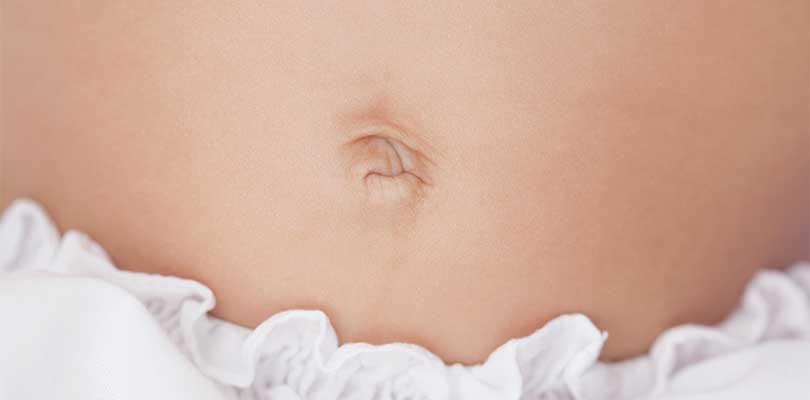What Is an Umbilical Hernia?
As a parent, you have enough to worry about. An umbilical hernia should not be something of tremendous concern—they are typically harmless. Read on to find out more about these hernias and when there is a reason to be concerned by this condition.
An umbilical hernia is a fairly common condition in babies, and, in most cases, they do not cause any problems. You’ll notice the umbilical hernia when you see or feel an abnormal bulge near the baby’s belly button. This mysterious bump is caused by part of the intestine or abdominal fluid coming through a hole in the abdominal wall inside the belly button. The hernia is the opening in the muscular walls—it is actually where the umbilical cord previously passed through. After the baby is born, this opening should meet and grow together completely. In some cases, it does not seal properly, enabling a loop of intestine or fluid to slip through the small hole.
Who Gets Umbilical Hernias?
Up to 20% of all children get an umbilical hernia. In newborns who are premature or have a low birth weight, umbilical hernias are more likely. Though it occurs most often in newborns, it can affect older children and even adults as well. The sex of the affected person does not matter, as boys and girls are equally affected by umbilical hernias.
Umbilical Hernia Symptoms
The telltale symptom of an umbilical hernia is the bulge or soft swelling near the baby’s belly button. There are a few characteristics of the bulge that may appear:
- The bulge is not static. When the baby cries, coughs, or strains, the bump may appear to swell more. When the baby’s quiet the bump may shrink or disappear. Keep in mind, the hernia is usually painless.
- The bulge can be pushed back in place. Gently pushing on the bulge when the child is lying down, will usually cause the bump to shrink or retreat back into the abdomen. Don’t push on the bump yourself, as this should only be done by a doctor.
- Distress and vomiting. Also, there may be additional swelling, or the hernia can appear discolored. This may happen when the intestines get trapped within the umbilical hernia. If your baby shows these symptoms, see a doctor right away.
What Are the Causes?
In normal fetus development, the umbilical cord passes through a small opening in their abdominal muscles, connecting them to their mother. After the baby is born, they do not need the umbilical cord so the muscles around the opening close as the baby grows. In a vast majority of cases, umbilical hernias are just the result of the baby’s umbilical ring not closing completely, which usually self-corrects over time.
In other cases, usually in adults, umbilical hernias are the result of other health conditions and factors:
- Elevated abdominal pressure
- Multiple pregnancies
- Previous abdominal surgery
- Fluid in the abdominal cavity
- Treatments for kidney failure
- Straining during certain activities
- Obesity
Breastfeeding vs formula is a controversial topic for most mothers, but when it comes down to it, it is your choice. Here are the pros and cons of each.
How to Treat an Umbilical Hernia
For a baby, exercising patience is the recommended treatment in a majority of cases. By the time your baby is 1 or 2 years old, the closure should seal on its own. Many other umbilical hernias close by the time your child is 3. If they have reached this age milestone and still have an umbilical hernia, see the doctor. They will determine how to treat the hernia taking into consideration the child’s age, health status, medical history and whether the hernia is reducible or strangulated. If the hernia is strangulated, it means that the intestine cannot be gently pushed back into its proper place, which generally warrants immediate surgery.
Surgery
No parent wants their child to have to go through surgery, but in some cases, it is necessary to repair the hernia. General anesthesia is given for surgery where the doctor makes a small incision near the bottom of the belly button. They’ll carefully place the intestine back in the abdominal cavity and repair the hole in the muscular wall with multiple layers of stitches.
Multiple stitches generally prevent another hernia and enable the hole to seal properly; once the hole is closed, another umbilical hernia is unlikely. Most children are able to go home a few hours after the surgery.
Can an Umbilical Hernia Be Prevented?
If the umbilical hernia occurs from birth, there is not really anything that can be done to prevent the hernia from forming. To help prevent umbilical hernias from forming later in life, do what you can to minimize pressure on the abdominal cavity. This would be actions like avoiding straining when lifting, keeping your weight under control and properly treating persistent heavy coughs.
Risk Factors for Umbilical Hernias
Umbilical hernias occur most often in newborns and babies. In infants, those who are most at risk are the premature babies and those with lower birth weights. Research also indicates that black infants seem to have a slightly elevated risk.
The Takeaway
Don’t stress out too greatly if your baby has an umbilical hernia. The numbers show that this is a common and generally harmless condition. If you notice that your wee one has a small bump near their button from time to time, take them to the doctor to confirm the diagnosis. Unless it is causing them pain, try not to fret about it.







